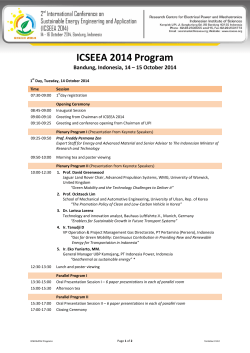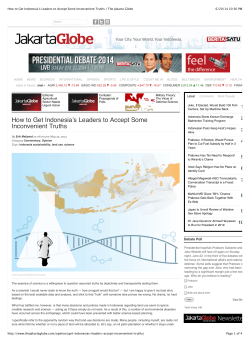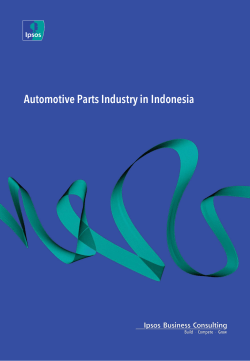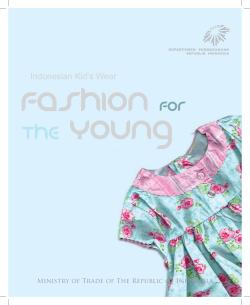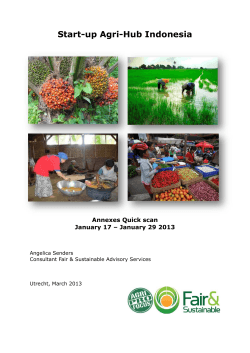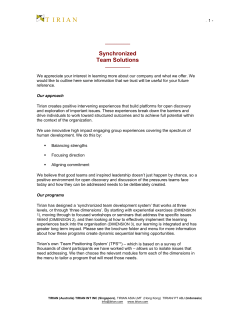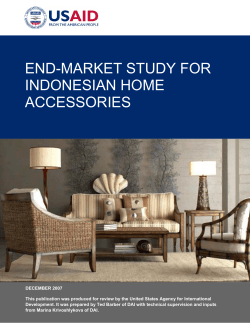
EVALUATION STUDY ON EXISTING CONDITION OF INDONESIAN CONSTRUCTION INDUSTRY:
EVALUATION STUDY ON EXISTING CONDITION OF INDONESIAN CONSTRUCTION INDUSTRY: HOW TO IMPROVE PERFORMANCE AND THE COMPETITIVENESS Dewi Larasati ZR* and Watanabe Tsunemi** Graduate Student of Kochi University of Technology* Professor of Frontier Engineering Kochi University of Technology** ABSTRACT: The growth of construction industry in Indonesia is now running slowly, compared to other industries. This slow growth is caused by the industry’s lack of efficiency. Such a drawback leads to inability of local construction companies to compete at international level. In the ever growing international competition the Indonesian construction industry must find ways to compete in an even competitive open global construction market. The inefficiency occurs because the characteristic of construction projects are in the state of constant changes. This is assumed as source of problems in the Indonesian construction industry because it does not cope with the adverse effect of changes, which is often causing poor performance result such as high execution fund, project execution delay, conflict among parties, and at the end causing high level of inefficiency. A profound study is needed to improve the efficiency of construction project delivery systems. To do this study, existing conditions of the construction industry in Indonesia should be evaluated first. Results of this evaluation expectantly can give a clearer figure of existing conditions of the construction industry in Indonesia and give direction in the next research to improve its performance and the competitiveness. KEYWORDS: construction project, Indonesian construction industry, performance, improvement of competitiveness. 1. INTRODUCTION In addition, other consequences arising from the As a developing country Indonesia needs a lot of poor performance are poor quality of infrastructure, development in the infrastructure field. Development which can not be utilized properly. This is preventing of infrastructure requires strong support from the the development process in Indonesia. Therefore, the construction industry. Although the construction various efforts and strategies are needed to improve industry plays a very important role in national the economic development at this time, however, the construction industry so that it can accelerate the development of this industry is running very slowly Indonesian development. when compared with other industries. performance and competitiveness in the On the other side, the construction project has This slow in growth among others is caused by the special characteristics such as generally high industry’s lack of efficiency; such poor performance fragmented-level and full of uncertainty with a tight result and drawback lead to inability of local budget and time constraint, which construction companies to compete at international frequent changes in project construction. level. results in the Unfortunately, the construction projects in Indonesia problems in the construction industry in Indonesia. often can not accommodate the changes. This is Finally, based on the identified issues, needs are assumed as the source problems of construction clearly defined needs, and strategies are proposed to industry in Indonesia because it does not cope with improve the performance and the competitiveness the adverse effect of changes, which is often causing construction industry in Indonesia. The research poor performance result such as high execution fund, methodology flow diagram is shown in figure 1. project execution delay, conflict among parties, and at the end causing high level of inefficiency. In the ever growing international competition, the Indonesian construction industry must find ways to compete in an even competitive open global construction market. Thus, they must improve their performance and ability to compete. This paper is compiled as initial effort in studying existing conditions of Indonesian construction, which contains primary study on characteristics of the construction project and existing conditions of Fig. 1. Research Methodology Flow Diagram the construction industry in Indonesia and analysis of the results of previous research related to the existing conditions of construction project in 3. GENERAL CHARACTERISTIC OF CONSTRUCTION INDUSTRY Indonesia. Result of this study expectantly can give To evaluate the condition of the construction clearer figure of Indonesian construction industry industry in Indonesia required a good understanding development, and give direction in the next of the characteristics of the construction industry. researches. In the future, next study will hopefully These characteristics will be used as a starting point give significant contribution in the construction to find the evaluation criteria that will be performed. project efficiency improvement, and improving Below performance and competitiveness. characteristics of the project and construction is the description about the general industry. 2. METHODOLOGY Construction projects have a life cycle consisting of Method of research is literature study from various several phases. Various parties are involved in the sources such as literature reviews of project project, and they have different responsibilities at characteristics, construction projects in Indonesia, each stage in the life cycle. More interfaces between and existing conditions construction projects in parties are needed. These imply that the project has a Indonesia and theoretical studies related to the topic. high level of fragmentation in nature. This Furthermore, the results of literature study are contributes to increasing complexity. analyzed to obtain thoroughly figure of the development condition of construction project in Indonesia. Based on the analysis result, it is expected to find the specific issues that are the root of the On the other side, spectrum coverage of construction project is very wide from the slow, certain, and simple construction project at one side, to the quick, uncertain, and complex projects at the other side (Ballard & Howell, 1998). Complexity level of From the explanation above, it can be concluded that construction project (Maylor, 2003) is determined the construction projects own a very complex based on three dimensions: those are required characteristic (Figure 2), and have an important resources complexity, technical complexity, and influence on the performance. It required efforts and organizational complexity. Based on type, the specific strategies to handle problems and changes construction project is classified into four categories caused by these characteristics so that this industry (Hinze, 1993 and Gould, 1997): those are residential can grow and develop well in Indonesia. construction, building construction, heavy engineering construction, and industrial construction. Each category has specific characteristic according to the project typology. Beside that, construction project has specific Construction Project Phase characteristics as follow: Unique product; different on each construction product (custom made product). Run by temporary organization; the organization will be disbanded by the end of the project. Its product depends on specific location or site, where the physical conditions (soil condition, water condition, etc.) and Construction Project Category non-physical conditions (regulation, traffic condition, etc.) are always different. Prime production process is conducted in site (on-site production), which depends on climate and uncontrolled environment condition. Fig. 2. General issue of construction project characteristic Changes associated with risk, Bettis on Ritchie This can be concluded that the construction project (2007) developed a model that links between risk, consists of various categories of very unique nature performance and industry characteristics as follows: so that the project owns very high uncertainty. In P = f (IC, SD, R) addition, the process itself consists of various phases, which is involving various parties (multi-party). This Where: takes a construction project into the environment that P = Performance of industry continues to change, as Smith (1999) presented the IC = Industry characteristic following: SD = Strategic Decision R = Risk Change is inherent in construction work. In all construction projects, ‘change’ is a defining characteristic and is almost inevitable. In construction project each of the three targets In other word, to obtain a good performance on the development of construction industry, it must be able to embrace change, considering the characteristics of of cost, time and quality likely to be subject of the risk and uncertainty. information to have strategic decision making. construction industry, and measure the 4. EVALUATION OF EXISTING CONDITION between site office and head office. This situation OF CONSTRUCTION INDUSTRY IN also gives opportunities to the local companies INDONESIA (almost small business company) in the regions to As mentioned previously, the construction industry develop their shelves. in Indonesian has played an important role in the national economy. In 2005, the industry’s direct contribution to the gross national product was about Kalimantan Island Sumatera Island 6%, and employed 7-8% of the country’s labor forces. There are over 116,000 registered Eastern Indonesia construction companies, while more than 99,000 among them are classified as small businesses Java Island (Sumardi et. al, 2007). 0% Based on data conducted by BCI Building & Construction Interchange Asia (2006) and The Indonesian Development of Construction Service Division (2006), most of service Fig. 3. 20% 30% 40% 50% Number of project (region) 60% 70% 80% Value of project (region) Comparisons between the number of large companies and the value of the project in the Indonesian islands of Other data (BCI Indonesia, 2006) indicates that by construction in Indonesia are located in Java Island, the project type category, the residential project for more than 50 % in all types of qualification reaches the highest number of projects but that the (Big/B/Large, Small/S project value is low. Hence, various projects in this business company). This condition resulted in a high category are executed by construction service firms level of competition between companies in Java with relatively small business company. The low Island. It requires companies in Java Island to have project value and the high number of projects in this the ability to survive. category need high efficiency to gain maximum Middle/M/Medium, firms 10% Number of big company and Spread of companies’ qualification shows that more than 70 % of B business, 64% of M business, and more than 35% of S business are resided in Java Island. Based on this condition, it seems that most projects with high value are fought over by companies located in Java (especially the B result and well competition. On the other side, in the Industry and Infrastructure project category, even though the value is very high, its quantity is quite few. high This (Figure 3). Because Retail Residential Recreation Oil Gas & Mining (Indonesia’s capital city, in Java Island) and only the Office B qualification can get the high value project, the Infrastructure Industrial location of project and head office becomes 0% different. A special strategy is needed to control the regulation of Utilities B qualification companies are mostly located in Jakarta level Building Construction Java have projects with high value, especially Island triggers competition (Figure 4). qualification). Moreover, several regions outside Kalimantan condition 5% 10% 15% number of project (catagory) Fig. 4. 20% 25% 30% 35% value of project (catagaory) Comparisons between the number of project type by category and the value of each project category in Indonesia The data also indicates that one-year budget amount Java Island. Consequently it is necessary to spent for concept and design phase, is larger than for increase construction phase competitiveness. (Figure 5). It is tendency to the efficiency to improve the the lack of “integrated tectonically approach” Construction industry in Indonesia is needed to (constructability) in totally project phases. This focus on maximizing project outcomes and indicates less integration in the project life cycle, and creating a good framework for developing a the process of design and concept do not take a collaborative environment between the parties collaborative process to improve the level of involved and to increase the level of project constructability. constructability. It also shows that the amount of budget for construction process very small compared with concept and design stage. This could implicate to the low quality of infrastructure products and the weakness of infrastructure support to the national development process. Construction Tender Documentation Design Concept 0% 10% 20% 30% Number of project (stage) Fig. 5. 40% 50% 60% Value of project (stage) Comparisons between the number of project stages Fig. 6. General issue of Indonesian construction Industry and the value of the each project stages Based on the results of the analysis on the data mentioned above, we can find the general issue of the construction project condition in Indonesia (Figure 6). Figure 6 shows the main issues of the construction industry in Indonesia based on the characteristics: There is a need for specific strategies related to the relationship between the company business organization and the project site office and local small business company (e.g. as subcontractor) such as supply chain management system. Level of competition is very high especially in existing condition 5. EVALUATION FROM PREVIOUS RESEARCH OF EXISTING CONDITION OF PROJECT DELIVERY SYSTEM IN INDONESIA Based on the main issues related to the characteristics of Indonesian construction projects, it is found that the project delivery system is a critical part of the construction industry and that the system is not run efficiently. Some research was conducted to evaluate some characteristics of Indonesian construction project and construction industry related to the issues. Wood, sub-contractors and suppliers. The disputes often et al, 2003 revealed that the delivery of major occur during the construction because the changes of international engineering projects in Indonesia has the scope of the work at the time of construction often been frustrated by the lack of appropriate often lead to the changes in the cost of materials, the necessity to waste valuable resources implementation work and result in changes to the on rework, absenteeism, interference and lack of the implementation of construction time. basic skills of workers. On the other side Kaming on Alwi et. al, 2003, investigated the performance and skill of Indonesian workforce compared with project Sukirno et al, 2007, said that the main causes of disputes on construction projects in Indonesia are: target output. He indicated that 1) efficiency of The external conditions (26.79%) working time is only 75% of percentage of working The change of drawing document (21.43%) time to total time, 2) its output index is only 87% of The condition of the field (19.64%) percentage of actual output to target output, and 3) The change of technical specifications (16.07%) the skill index is 67% of the index which ranges Other factors (16.07%) from 0 – 100 given that 100 is excellent. This shows the performance of the construction process in Indonesia is very low and highly inefficient. This shows that the main cause of disputes in the construction process is the uncertainty and changes in the scope of work. The uncertainties are included According to Alwi et al, 2003, the low level of in 'The external conditions' and 'The condition of the performance in the Indonesian construction process field' (total 46.43%), while the changes are is caused by the high level of waste. The waste is included in 'The change of drawings document ' and caused by some factor of the following; repair on 'The change of technical specifications' (total 37.5%). finishing works, waiting for materials, delays in Other causes of error are among the cost estimates, schedule, slow tradesmen, waste of raw materials professional ethics, the licensing and others. Those on-site and lack of supervision. Meanwhile, the key problems indicate that the construction industry in variable of these factors are (Alwi et al, 2003): Indonesia is not ready to anticipate the changes and uncertainty, and this is a major cause of inefficiency design changes, in Indonesian construction industry. slowness in making decisions, lack of trades’ skill, According to Sakkal, 2005, the various relationships inappropriate construction methods, that occur at this time often can not anticipate the poor coordination among project participants, changes and uncertainty because the relationship delay of material delivery to site and poor between the parties in the process of construction is planning and scheduling a traditional contract. Similarly in Indonesia, the Therefore, most of Indonesian contractors are facing problems in relation to delays in schedule. Delay of project completion is a serious problem in contractual relationship between the parties on the construction project is a traditional pattern that does not embrace changes and uncertainty. Indonesian construction project. In a certain case, Studies on the relationship that occurred in the delays often contribute to costly dispute and construction process in Indonesia have also been adverse relationship amongst the project participants conducted. A research by Syachrani, 2004, indicates such that the existing conditions of the relationship as clients, consultants, contractors, between contractors and suppliers on Indonesian construction project are only ‘transactional relationship’, so that the role of suppliers in achieving the project goal is still limited. different parties Related to supply chain approach, what is believed as one strategy to improve construction project productivity is to strengthen production unit This also happens in the relationship between (Vrijhoef, et.al, 2000) in which construction project contractors and owner, and the relationship is an context refers to contractor and subcontractor or antagonistic relation. Most of the construction supplier. Competition in construction world that industries seem resigned to the fact that there’s no happen nowadays, is not among companies anymore, better way to conduct business. Therefore, they but among supply chain network (Christopher, 1998). continue to experience the negative ramification of Efficient supply chain will give high competitiveness using traditional forms of relationship. They are very for the companies that are involved in the chain. difficult to accept new concepts to improve Therefore, each company always tries to develop performance and hard to adapt new idea. strong and trusted supply chain and to optimize the Indonesian construction project have problematic possible chain and benefit. issues with using traditional relationship. It is hard to Early research of Indonesian construction project focus on maximizing project outcomes and creating supply chain has been conducted by Susilawati a good framework for developing collaborative (2005). But the research scope is limited to building environment between the parties involved. construction project and the project that uses In the other side, in the residential construction execution nowadays in Indonesia, the relationship represents short term contract for a lot of work packages (Sandra EF, 2006). This relationship is traditional delivery project system with high fragmentation. From the research, some influencing factors in forming network in construction industry in Indonesia are found. They are: causing contractual links among developer and Type and scale of project several contractors at the same time. This matter Contract method selection generates a number of supply chains at the same Project location time in the near locations. This creates some supply Regulation of construction service procurement chain network on the same resources. For that reason, Organization structure and project management each contractor has to conduct procurement, distribution, and storage, which at last increase execution fund of residential building construction. Short term relationship and a number of contractors at the same time increases inefficiency because the wide scale construction is not conducted by mass construction principles with central management. Amount of involved contractors in construction location and the absence of information flow in each contractor generate supply chain in each contractor through using each supplier and subcontractor. By this practice, a number of activities are handled by On the other word, specific project characteristic is to form specific network and supply chain in construction project in Indonesia so that specific role of each involved parties are generated. However, from previous information, it is found that the construction industry in Indonesia do not have a good management ability which are constrained by the use of traditional relationship pattern, inadequate existing regulations in the procurement process, and many obstacles faced in the process of project delivery, etc. Based on the above discussions, we can summarize Based on the various explanations above-mentioned, some specific issues and problems of the inefficiency the main problems in the construction industry in in Indonesia construction industry as the following Indonesia are identified. The following needs and (Figure 7): proposed some strategies are required to improve the performance and capabilities of the competitiveness The production process in the construction industry in Indonesia is not run smoothly. This is in the construction industry based on the main problems that arise, which are: indicated by a problem on project delivery Promotion and development of techniques system such as lack of appropriate material and related to planning production process and work the necessity to waste valuable resource on flow are needed. The strategies that can be done rework, etc are to develop the Indonesian construction Low skill index and experience of construction worker make the business resistance in conducting new concepts. industry towards a more integrated network, such as the development of supply chain management system. Therefore, the industry needs to work on collaboratively network of Fragmentation in the project delivery process is still too enormous, and this is indicated by a disintegrated relationship between the various parties involved. Most of the relationship is going with the traditional patterns which cause lack of clear lines of communication and lack of good work relationship of not embracing change. This results in the project delay, waste and dispute interrelated processes structured to best project result. Development of new relationship pattern is needed to cope with the adverse of change and uncertainty such as relational contracting mechanism. This relationship must be supported by good systems of risk management and value engineering. caused during the construction, increase in Develop utilization support and an applicable antagonistic relationship. Most of these are due model in the development of new concepts (or to an overall lack of trust of one another. approach) is needed to change to better condition. Since the construction industry is in the ‘change The model should be simple, non-technical, and environment’ and construction industry also suitable to the culture and political in Indonesia can not anticipate the changes, the risks that arise in the Indonesian construction industry are very high. condition. Lessons are desirably learned from best practices in developed countries such as Japan. According to the specific issues above, the industry A description of the problem and its efforts and needs efforts and strategy to have good performance strategies are summarized in Figure 7. and high competitive power. 6. THE NEED AND STRATEGY TO IMPROVE THE PERFORMANCE AND COMPETITIVENESS project. The model should also be suitable to the culture and political condition. Lessons are desirably learned from the best practices of Japan construction industry or other developed countries to help the model development process that actually can be implemented. In future, research needs to be done to develop the model. REFERENCES Alwi, Sugiharto et al, 2001. Effect of Quality supervision on rework in The Indonesian Context, Asia Pacific Building and Construction Management Journal 6:pp. 2-6, Copyright 2001 Chartered Institute of Building (Hong Kong). Alwi, Fig. 7. The problem statement and the need of improvement Sugiharto, 2003, Factors Influencing Construction productivity in The Indonesian Context. Proceedings The 5th EASTS Conference, Fukuoka, effort to increase the performance and the competitiveness Japan. 7. CONCLUSIONS Ballard, et. al, 1998. What Kind of Production is To accelerate the development in Indonesia as a Construction, Proc. 6th Annual Conference of the developing International Group for Lean Construction. country required infrastructure development performance. This can be the that support has a achieved of good through improving the quality of the construction industry. Therefore, Indonesia needs to improve the BCI Building & Construction Interchange Asia, 2006. Indonesian Construction Project Data, BCI Indonesia Magazine, Ed.2006. performance of the construction industry because the Christopher, M., 1998. Logistics and Supply Chain current condition indicates that the industry is Management, Second Edition, Prentice Hall (book). insufficient and has low performance and competitiveness. Vrijhoef, R. & Koskela, L., 2000. Roles of Supply chain Management in Construction. Proc., 7th The strategies proposed in the process of increasing Annual Conf. of the International Group for Lean efficiency and competitiveness is the development Construction. model of ‘Supply Chain Risk Management System with Relational Contracts Mechanisms, using The Performance Information System Approach’. Ritchie, Bob, et. Management and al, 2007. Supply Chain Risk Performance, A Guiding Framework for Future Development, International The model used should be easy to use and simple but Journal of Operation and Production Management, can accommodate a variety of risks and uncertainties Vol. 27, No. 3, pp. 330-322, Emerald Group caused by the characteristics of the construction Publishing Limited. Sakkal, Matthew, M, 2005. Project Alliancing: A Relational Contracting Mechanism for Dynamic Project, Lean Construction Journal Vol. 2, 1 April 2005, ISSN: 1555-1369. Sandra, E.F., 2006. Kajian Hubungan Kerja Antar Pihak Terlibat dalam Pelaksanaan Konstruksi Bangunan Perumahan, Master Thesis, Civil Engineering, Bandung Institute of Technology. Smith, N, J, 1999. Managing Risk in construction Project, First Edition, Blackwell Science (book). Soemardi, B.W, et al, 2007. Preliminary study on the Indonesia construction Industry Supply Chain System. International Seminar Proceeding of ASEAN University Engineering Network/Southeast Education Development Asia Network (AUN/SEED), Bangkok Thailand. Soekirno, P., et al, 2007. The disputes in the Construction Project in Indonesia, Reference Books, Construction, Industrial, Management, and Engineering, ITB Publisher, ISBN 979-3507-98-5 Susilawati, et al, 2007. Study of Contracting Procurement by the construction of Building Projects, Journal of Civil Engineering ITB Vol 13 No.3, July 2006, ISSN: 0853-2982. Syachrani, et.al, Pemilihan Rantai 2004. Model Pemasok SistemEvaluasi Beton Ready-Mix Sebagai mitra dengan Mempertimbangkan Aspek Negosiasi, Proc. Seminar on 25 Year of Construction Management Education in Indonesia, TS 32-2.
© Copyright 2025

